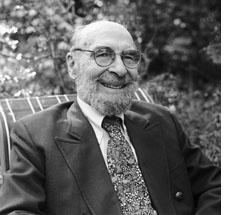
Fall
2000
![]()
Luminaries
Seven
notables contemplate the state of humanities, arts, and social sciences
at MIT and beyond.
![]()
![]()
Soundings is a publication of the School of Humanities, Arts, and Social Sciences at MIT
Comments and questions to shass-www@mit.edu
Biography becoming history
 Photo: Graham G. Ramsay |
Bruce Mazlish is professor of history. He joined the MIT Faculty in 1950, left for two years, rejoined it in 1955 and has been here ever since. He served as Head of the Department of Humanities (Course XXI) from 1974 to 1979.
Why would a liberal arts scholar come to MIT and stay for almost 50 years? My answer is necessarily personal; but perhaps a biography can aspire to become history, and especially institutional history.
The initial reason involves John Burchard, then Dean of the School of Humanities and Social Science. It was his vision of the place of humanities at the Institute that caused me to accept an offer. He believed in interdisciplinary work and what was called Gen. Ed. In back of this belief was the conviction that the Institute should produce "leaders," not just technologists or scientists. Supporting Burchard stood Presidents Jim Killian and a little later Jerry Wiesner. As one trained as an intellectual and cultural historian of modern Europe, but always straining at the geographical and chronological ties, I felt engaged by their vision.
What kept me at MIT were some of my colleagues. There were two great polyhistors. One was Giorgio de Santillana, in the history of science; known as "the cat who walks alone," he became a friend as well as a colleague. The other was Karl Deutsch, who later shifted from history to political science. Deutsch's shift was partly motivated by Norbert Wiener, and I too basked in the great mathematician's presence, remembering fondly his appearance at my office door with a manuscript under his arm, saying "Will you read this, my novel?" (As it happens, he did not want criticism, but undiluted approval). Then there was John Blum, eminent American historian and wise in the ways of academia; Alfred Chandler, on his way to eminence as the premier historian of business (and still my colleague, as we work together on a current project). And then for one short year, Jacob Bronowski, who came as a visiting Carnegie Professor, became my collaborator on my first book, a close friend and godfather of one of my sons.
Other factors in my remaining at MIT were the students, always a challenge; the stimulus of science and engineering, continually at the cutting edge; and, of course, Cambridge, where everything exciting would come sooner or later.
At first, the schedules were heavy: nine hours, three courses, and six days a week. The classes were mostly male; the few women who showed up in my classes were from Wellesley; there were no tenured women faculty in humanities. All that, of course, has changed. I came to know the Institute from another perspective and participated in some of its transformations through a chance appointment to administrative posts. For five years I served as chair of the history section, and for five years as head of the entire humanities faculty, which then numbered over 140 and embraced numerous disciplines, including philosophy. In these posts, I helped preside, with mixed feelings, over a shift to greater professionalism—the publish or perish syndrome—the setting up of a Writing Program, and the breakup of the Humanities Department into separate units, along with the hiving off of history of science into a newly created Science, Technology and Society program. As in all things, each has its advantages and disadvantages; professionalism can carry with it provincialism and narrowness of spirit, but also sharpened attention to research.
I have no doubt that these tensions and possibilities will continue at MIT into the next 50 years, as will the ability to change and be flexible on the part both of the Institute and the liberal arts that comprise such a vital part of its educational and research agenda.
![]()
Copyright © 2000 Massachusetts
Institute of Technology